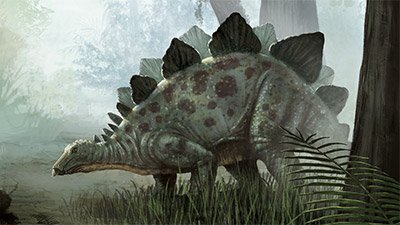
Dinosaurs and Humans
Dinosaur Bones and Human Bones
Old-earth proponents often argue that if man and dinosaurs lived at the same time, their fossils should be found in the same layers. Biblical creationists believe that man and dinosaurs lived at the same time because God said that He created man and land animals on Day Six. Why don’t we find human fossils with dinosaur fossils?
Dinosaurs on Noah’s Ark?
The Bible states that two of every kind of land animal and seven of some went onto the Ark. Some skeptics ask, “How could two of every kind of dinosaur fit on the Ark?” If dinosaurs sailed on the Ark, where are they today?
Dinosaurs and Humans Together
There are many references to historical evidence of dinosaurs and man living together, such as the petroglyph in Natural Bridges, Utah, legends and stories of dragons in Europe, and use of the dragon motif by the Chinese. But one striking physical in Asia is the bas-relief picture of a dinosaur in the ruins of Angkor outside of Siem Reap, Cambodia.
Crocodiles, Dinosaurs, and Humans
According to evolutionary time, crocodiles have been around since the time of the dinosaurs—and yet, humans live with crocodiles today. So why is it ridiculous to think humans and dinosaurs lived at the same time?
News About Dinosaurs and Humans
-
May 1, 2018 from Ken Ham Blog
Was there ever an advanced civilization on earth before humans? That’s the “thought experiment” being posed in an article published by two astrophysicists.
Articles About Dinosaurs and Humans
-
Oct. 1, 2025 from Answers Magazine
Did dinosaurs and people even coexist? Could dinosaurs have fit in the ark?
-
Aug. 30, 2025 from Answers in Depth
Depictions and documentation of dinosaurs, pterosaurs, and large marine reptiles living with man
-
Magazine Department ArticleOld Dinosaurs Never DieJuly 1, 2015 from Answers Magazine
On the heels of Steven Spielberg’s fourth Jurassic Park movie, Jurassic World, comes Pixar’s The Good Dinosaur.
-
Feedback ArticleA Psychologist Who Couldn’t Control HimselfMarch 15, 2013 from Feedback
An unusually hostile letter to the editor recently appeared in a newspaper in AiG’s home state. It was memorable for its mistakes as well as its tone, and we decided to reply promptly.
-
Feedback ArticleDinosaurs Living with People—The Biblical WorldviewMay 4, 2012 from Feedback
Tim Chaffey, AiG–U.S., responds to yet another hostile reader, who takes particular offense to the idea that dinosaurs and humans coexisted.
-
Tracks of Co-Existing Humans and Dinosaurs Found In ChinaOct. 22, 2011 from News to Know
Yes, dinosaurs and humans co-existed—but not in the Lotus Mountain Fortress.
-
Feedback ArticleDinosaurs in the LobbyOct. 15, 2010 from Feedback
A recent visitor to the Creation Museum wonders about our depiction of children playing next to young dinosaurs. Tim Chaffey, AiG-U.S., addresses these concerns.
-
-
Magazine ArticleDinosaurs on the ArkFeb. 24, 2010 from Answers Magazine
Did dinosaurs really live at the same time as humans? Genesis 1 claims that God created every “kind” of land animal on the same day as Adam.
-
Just Kidding! Dinosaurs are Birds!June 13, 2009 from News to Know
Creationists don’t claim dinosaurs are alive today. But since we know at least two of each dinosaur kind survived Noah’s flood, we view the possibility as notably more likely than evolutionists do.
-
Feedback ArticleDinosaurs, Man, and the BibleMay 9, 2008 from Feedback
We respond to two readers with similar misconceptions about dinosaurs and the Bible.
-
Feedback ArticleDid T. rex taste like chicken?Aug. 31, 2007 from Feedback
A scientist scoffs at the idea of dinosaurs and humans coexisting. Dr. Purdom responds.
-
Evidence of Dinosaurs at AngkorJan. 15, 2007
There are many references in creationist literature to historical evidence of dinosaurs and man living together. But one striking physical and historical evidence in Asia is rarely mentioned: the bas-relief picture of a dinosaur in the ruins of Angkor outside of Siem Reap, Cambodia.
-
We’ve Invaded Their “Temple”!May 1, 2005 from Answers Update
Almost every time there's news in the secular press about Answers in Genesis, the reporter will mock the fact that we believe dinosaurs and humans have lived at the same time.
-
Magazine ArticleAustralia’s Aborigines ... Did They See Dinosaurs?Dec. 1, 1998, pp. 24–27
Australian Aborigines have stories of encounters with huge, sometimes frightening monsters which range from what sound like dinosaurs to giant marsupials, also believed to have long become extinct.
-
Magazine ArticleDino-MightDec. 1, 1997, pp. 43–44
The monstrous creature was obviously a vegetarian, but its size was overwhelming. Its hips were built to withstand the enormous force of each pounding step and its midsection was a mass of muscle.
-
Magazine ArticleDinosaurs Living in Africa?March 1, 1995, pp. 19–20
In 1919, rumours abound about a large animal seen in the interior of the Congo, in Africa.
Recommended Resources

Answers in Genesis is an apologetics ministry, dedicated to helping Christians defend their faith and proclaim the good news of Jesus Christ.
- Customer Service 800.778.3390
- Available Monday–Friday | 9 AM–5 PM ET
- © 2026 Answers in Genesis






